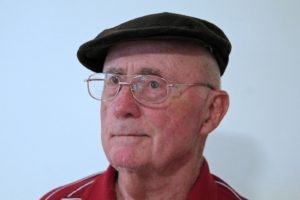AGRICULTURE ORAL HISTORY INTERVIEWS
JOHN HARRIS
Fishing Creek Valley Road
Harrisburg, PA
Interviewed by Jane Hoover September 29, 2015
John (b. 1933) spent his entire working life with Penn State Extension. When he was invited to become the Extension Agent in Perry County in 1981, he and his wife Carolyn continued to live on their farm on Fishing Creek Valley Road in Dauphin County, where he had been working in Extension for 19 years. John worked 8 years in Perry county, retiring in April 1989.
JANE: Why did you come to Perry County?
JOHN: Well I had been in Dauphin County for 19 years and I knew the boss county agent was going to be retiring very soon. He was very good with turf, shrubs and ornamentals and I wasn’t too enthused with that. When the opportunity presented itself, when Roy Snyder told me he was going to retire, I thought to myself, there are not too many other counties that I would have left Dauphin county for. Perry County was one of them. And I was awfully glad I did.
When I was in Dauphin County I could be walking down the street and somebody comes walking by, you don’t say anything. When I went to Perry County, out of the courthouse or down the street, and you met somebody, it was “Well, how you doing?” Everybody wanting to speak with one another. I always did say, if I went to speak with strange people in Harrisburg, jokingly they said they would lock me up in chains and put me away. They were kidding me, then.
One thing I noticed real quick, is that the other ag agencies (Soil Conservation, Farm Service Agency, Soil Conservation District and the Farmers Loan Agency) they were willing to help one another. Many’s the time, the Soil Conservation people would ask for my help, or they would help me. When I retired and Dave Swartz came in, he couldn’t get over how helpful the agencies were with one another. He would joke that it would take a nuclear explosion to get them to help like that in other counties.
JANE: What was your job in Perry County?
JOHN: Conduct the educational programs, including 4-H club work, sponsoring ag education meetings, in an emergency help out.
Got heavily involved with the Fair. The Fair, when I first got to the county, they had tents for the exhibits to be put in. I’ll never forget there was some serious discussion as to building a barn or expanding the barn. A lot of the farm people batted it back and forth. There was some resistance. I can remember the time they were building a barn for the animals and they thought a 40×40 show ring would be enough. Oh, I said that’s like a postage stamp. So a day or two before I retired, I said to Joe Stolphus, who was on the Fair Board at that time, don’t let them build a 40×40. A 40×80 is the smallest you should have. I don’t know if I had any influence there or not, but the thing is extension agents make recommendations sometimes you never know until years later how important that decision was.
The success of a 4-H program is really the leaders in the county, the people who are willing to give their time.
JANE: Who were some of the 4-H leaders you remember?
JOHN: Well, Hulda Dum, a fine person. Ken Benner was a good leader of the Dairy Club. That the Livestock Club had a real successful show and sale and promotion came about because a man called Jim Curtis came to Perry County from Maryland, I can’t recall the county. He had been heavily involved in 4-H work in Maryland, but Jim’s efforts are some of the reasons the livestock farm and sale are what they are today. The success or failure of a 4-H program is due to leaders who volunteer their time. The current (2015) 4-H leader Resta Tressler has served for 54 years.
I remember going to this boy’s home and the 4-H leader said, “Now I want you to see his garden,” and so we did. I want to tell you, that was something else, the exotic vegetables and flowers, half of which I didn’t know what they were. The leader turned to me and said, “Mr. Harris, how would you like to critique his vegetable garden?” and I thought, well, why don’t we let Danny tell it about his vegetable garden. He did all the work, and that’s the way it turned out.
I had a little bit to do with the Master Farmer program. We had six Master Farmers I had the opportunity to present. I remember the first farm I was involved in was Eddie and Keith Martin. Then Ken and Jane Benner, Ben and Donna Dum, Bob and Bernice Gable, Jim and Sandy Hoover, and Clark and Donna Bower. I didn’t go out and seek Master Farmer applications. Someone suggested I ought to consider Clark Bower. So I went to see Clark to see if he might be interested. Clark said yes. So we did. The committee of reviewers from the five Land Grant Universities (Pennsylvania, Maryland, New Jersey, Delaware, West Virginia) go around to look at the top ten applicants to see how well they keep the farm up. Clark had an AI (artificial insemination) breeding demo, so he cleaned the place up real nice for the AI breeders. That was the same day as the reviewers came around. Clark’s place was sparkling like a diamond.
JANE: What was your role in advising farmers?
JOHN: One farmer said, “Boy I’m losing a lot of calves to pneumonia. I went to visit that farmer and he had the little calves in the back of a bank barn where it was damp and cold. I advised him to get the calves out of the barn and into a dry environment. The word got around so a lot of fellows did the same thing.
JANE: What changes in ag practices have you seen?
JOHN: Plant genetics, corn, alfalfa varieties. People are concerned about spraying for corn insects, but the genes today permit plants to kill corn borer or corn root worm when they start to eat the corn, so you don’t need to spray.
We didn’t have very many large dairy herds when I came, but there were many 100+ herds when I left. Herds needed to increase to permit sons to take over and expand. Yet, two herds in Perry County still are not real big (40-50 cows), but have installed robotic milkers. That’s $250,000 per robot. They allow people to manage herds without getting up at 4 AM because now there is free choice from the cow. Dennis Weller said his herd has done better after robots were installed. That will be a trend.
Other trends are the use of AI, hybrid corn with stronger stalks and better yields, GMO’s, GPS is allowing tractors to plant corn without a driver and be within 6″ of the last row. No-till is replacing the plow and disc.
One thing that irks me is complaints about antibiotics in milk. When that truck comes out to the farm to pick up my milk, a sample is taken of the milk before it is loaded on the truck. It is taken to plant, all mixed together with the rest of the milk. But the ability to test for the presence of antibiotics is tremendous. You can take a small glass and dump it into a big tanker and you still can detect any antibiotics in it. The dairy rejects the entire truck and they dump it. Hard to hide it. You can trace the source because they have the little sample labeled for each farm. So many non-farm people have no idea how well-protected their food is.
The best part about Extension is the people you meet. Perry County has the leadership to be great.

